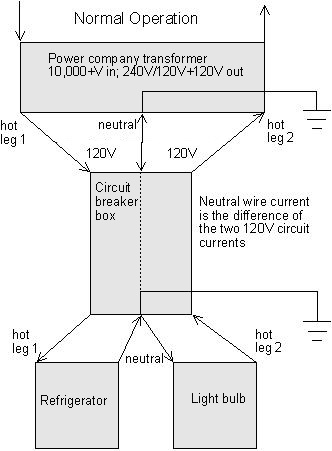Loose Neutral Power Problems
Under normal circumstances, some amount of light bulb dimming (voltage drop) can be expected when turning on high-current appliances like vacuum cleaners, garbage disposals, televisions, and welders. However, light bulbs should never get brighter (voltage spikes), which indicates something is seriously wrong. Also, voltage drops should not be severe enough to turn off devices like televisions, computers, or washing machines.
This discussion was sparked by my father's serious power problems that ended up frying numerous electronic devices and stumping several professional electricians. Many light bulbs in his house would flicker brighter and dimmer when his refrigerator or dish washer turned on or changed cycles. The voltage spikes ended up frying the power supplies in his television and stereo. I hooked up a laptop-based data acquisition system to one of his 120V circuits and sampled the voltage at 10000 samples per second. The normal 120V RMS sinusoidal power graph looked normal with peaks at +/-170V. When we opened the refrigerator door and it kicked on, I measured spikes as high as 340V, which happens to be the peak voltage of 240V RMS sinusoidal power. Very strange.
I came across an email thread that just mentioned loose neutral as a possible cause for voltage spikes, but no explanation or reference was given. I did some reading about power company connections to the electrical service (circuit breaker) box inside the house. Here is a diagram of a simple setup under normal circumstances. The arrows show power flow during one half of the AC cycle; the arrows would all reverse during the other half of the AC cycle. The neutral wire is connected to earth/ground at the transformer and at the circuit breaker box.

The important thing to notice is the direction of the current flow in each 120V circuit. If the current in each 120V circuit is the same, the circuits are balanced and no current flows in the neutral wire back to the power company transformer. If the circuits are unbalanced, like having a bunch of lights on one circuit and nothing on the other, the difference in the two currents flows through the neutral wire. For example, if one 120V hot leg has 30A of current flowing through it and the other 120V hot leg has 40A of current flowing through it, the neutral wire will have 40-30=10A of current flowing through it. Under normal circumstances, no current will flow through the earth/grounding wire.
We performed a test to try to check neutral wire performance. We turned off all 240V appliances including the dryer, hot water heater, heat pump, and furnace. Next we turned on many of the lights in the house. We measured currents in the circuit breaker box using a clamp-on current meter. The currents in the two 120V hot wires at the top of the circuit breaker box were unbalanced at 15A and 5A. The current flowing through the neutral wire should have been close to 10A, but it was only about 5A. I then measured the grounding wire current, which was also about 5A. Some electricity was flowing back to the power company transformer through the literal ground, which is very bad. In this steady state, there was no flickering or dimming. My theory is when a quick change in current draw occurs, like the refrigerator kicking on, the imperfect neutral and ground connections cannot keep up with the required unbalanced current flow and the two separate 120V circuits are seemingly connected in series across all 240V for fractions of a second at a time. Below is a diagram of the loose neutral behavior.

In this situation, you will get both severe voltage drops and voltage spikes depending on the types of loads and how they are connected.
After a lot of back and forth with the power company, and having to prove the problem was outside the house, they dug up and replaced some wire by the power company transformer. This is not a common problem, so they took a lot of convincing. You could get the same behavior from a loose neutral connection at the circuit breaker box inside the house, but that was easy to check and that was not the case. The new rock-solid neutral wire connection to the power company transformer totally fixed the problem. They only offered to reimburse depreciated value for the electronics and appliances that got fried, so not very much.

